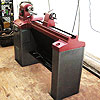Ever since I started making turned objects, my pieces seem to have grown continually in height. At this point, they are averaging 15-17" tall and with the pieces being perched on long slender stems, they do not exactly have a low center of gravity. To put it another way, they tend to be "a bit tippy". So I have been trying to come up with a way to add some mass (weight) to the bases without ruining the "esthetics". I had thought about inlaying a 1/8" thick brass disk into which I could also engrave a signature. But the idea just did not satisfy. Then I came into some 1/8" diameter lead "wire" and that gave me this idea. It took three tries to make this base without cutting into the little rabbet and exposing the wire. But I finally got it right. I am hoping this will help with lessening the tippyness. (Is that good grammar? "...lessening the tippyness"?)
First a recess formed in the underside of the base:
base_1.jpg
Then a second piece is turned to fit. A small rabbet around the edge, wrapped with the lead wire:
base_2.jpg
The two pieces are then glued together:
base_3.jpg
Now the bottom of the base is turned and the lead wire is hidden inside the bead:
base_4.jpg





 Reply With Quote
Reply With Quote









